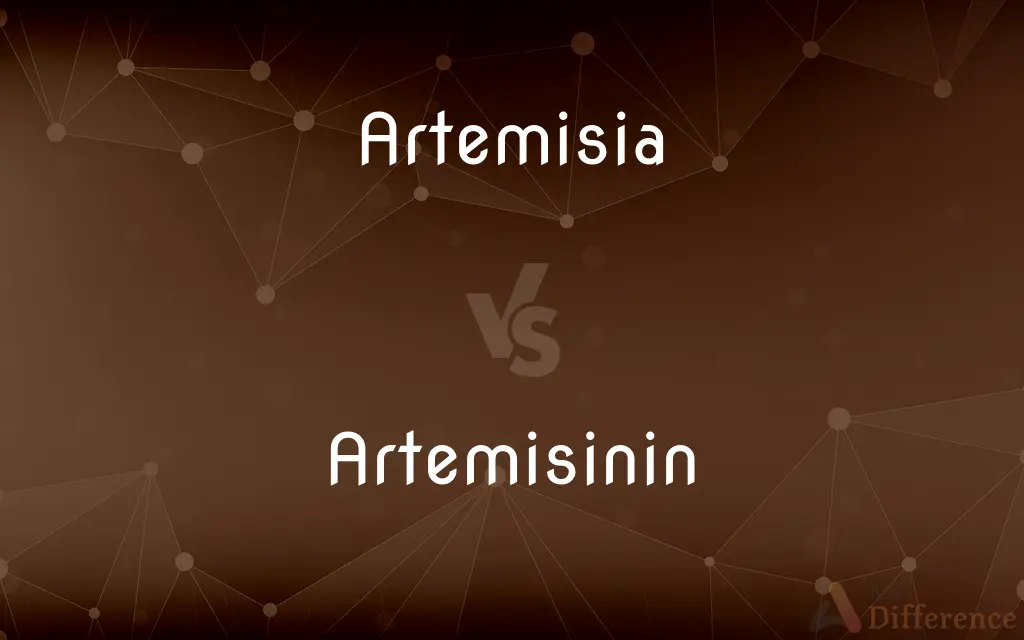Artemisia vs. Artemisinin — What's the Difference?
By Urooj Arif & Maham Liaqat — Updated on April 15, 2024
Artemisia refers to a genus of diverse plants known for their aromatic qualities, while Artemisinin is a compound derived from one of these plants, used primarily as a malaria treatment.

Difference Between Artemisia and Artemisinin
Table of Contents
ADVERTISEMENT
Key Differences
Artemisia is a genus encompassing various plants, often used in decorative and medicinal contexts. Conversely, Artemisinin is a specific compound extracted from the Artemisia annua plant, notable for its anti-malarial properties.
While Artemisia plants are recognized for their aromatic leaves and ornamental value in gardens, Artemisinin plays a critical role in medicine, especially in regions affected by malaria.
In terms of application, Artemisia species like Artemisia absinthium are used in making absinthe and other herbal remedies. On the other hand, Artemisinin is utilized in pharmaceuticals, formulated into drugs to combat malaria.
Artemisia plants have a broad range of species with varying uses, from culinary herbs to traditional medicine. In contrast, Artemisinin is focused primarily on its efficacy in treating malaria, demonstrating its specialized application.
Additionally, the cultivation of Artemisia involves agricultural knowledge and practices to grow various species effectively. Meanwhile, the extraction and refinement of Artemisinin involve chemical processes to isolate and utilize the compound for medical purposes.
ADVERTISEMENT
Comparison Chart
Definition
A genus of diverse plants with aromatic qualities
A chemical compound derived from Artemisia annua
Primary Use
Decorative, culinary, and medicinal
Anti-malarial treatment
Application Example
Used in absinthe and herbal teas
Used in drugs like artemether and artesunate
Species Variety
Includes many species like A. absinthium, A. dracunculus
Specific to Artemisia annua
Field of Relevance
Horticulture, traditional medicine
Pharmaceutical medicine, specifically in malaria treatment
Compare with Definitions
Artemisia
A genus of plants known for their aromatic leaves.
The garden was filled with the scent of Artemisia.
Artemisinin
A compound effective against malaria.
Artemisinin has dramatically improved malaria treatment outcomes.
Artemisia
Includes species used in culinary arts, like tarragon (Artemisia dracunculus).
He flavored the sauce with fresh tarragon from the garden.
Artemisinin
Used in combination therapies for malaria.
Artemisinin-based combination therapies are recommended by health authorities.
Artemisia
Found in various decorative forms for landscaping.
Artemisia 'Powis Castle' is popular for its silver foliage.
Artemisinin
Has a role in reducing malaria transmission rates.
Widespread use of artemisinin has helped lower malaria incidence in endemic areas.
Artemisia
Commonly used in traditional and herbal medicine.
Artemisia vulgaris has been used in folk remedies for centuries.
Artemisinin
Investigated for potential anti-cancer properties.
Recent studies explore artemisinin’s effectiveness against certain cancer cells.
Artemisia
Associated with the making of absinthe.
Artemisia absinthium is a key ingredient in traditional absinthe recipes.
Artemisinin
Extracted from the Artemisia annua plant.
They cultivated Artemisia annua specifically for artemisinin production.
Artemisia
Any of various aromatic plants of the genus Artemisia in the composite family, having green or grayish foliage and usually numerous small discoid flower heads and including mugwort, sagebrush, tarragon, and wormwood.
Artemisinin
A compound, C15H22O5, that is obtained from a species of artemisia (Artemisia annua) and has antimalarial activity.
Artemisia
Any of many aromatic flowering plants of the genus Artemisia, including wormwood, sagebrush, and tarragon, often used as traditional medicine and flavouring.
Artemisinin
Artemisinin () and its semisynthetic derivatives are a group of drugs used in the treatment of malaria due to Plasmodium falciparum. It was discovered in 1972 by Tu Youyou, who shared the 2015 Nobel Prize in Physiology or Medicine for her discovery.
Artemisia
A genus of plants including the plants called mugwort, southernwood, and wormwood. Of these Artemisia absinthium, or common wormwood, is well known, and Artemisia tridentata is the sage brush of the Rocky Mountain region.
Artemisinin
Any of several semisynthetic derivatives of this compound that are used to treat malaria, usually in combination with other drugs.
Artemisia
Any of various composite shrubs or herbs of the genus Artemisia having aromatic green or grayish foliage
Artemisinin
An antimalarial drug derived from the sweet wormwood shrub, Artemisia annua, found as the active ingredient in traditional Chinese medical herbal treatment for malaria, chemically a sesquiterpene lactone - C15H22O5.
Common Curiosities
How is Artemisinin used in medicine?
It is primarily used to treat malaria through specific drug formulations.
What are the main uses of Artemisia plants?
They are used for decorative, culinary, and medicinal purposes.
Is Artemisinin available over the counter?
No, artemisinin-based treatments are prescription drugs.
What makes Artemisinin effective against malaria?
It attacks the malaria parasite during the reproduction phase in the human blood stage.
How did Artemisia plants get their name?
Named after Artemis, the Greek goddess, reflecting their ancient medicinal use.
Can Artemisia plants be used in cooking?
Yes, certain species like Artemisia dracunculus (tarragon) are used as herbs.
Are all Artemisia species medicinal?
Many have medicinal properties, but not all are used for health-related purposes.
What are the environmental requirements for growing Artemisia?
Most species prefer sunny locations with well-drained soil.
How is Artemisinin extracted?
It is extracted from the dried leaves of Artemisia annua through a chemical process.
What research is being done on Artemisinin?
Research includes its potential anti-cancer properties and use in treating other human diseases.
Share Your Discovery

Previous Comparison
Byline vs. Line
Next Comparison
Design vs. ShapeAuthor Spotlight
Written by
Urooj ArifUrooj is a skilled content writer at Ask Difference, known for her exceptional ability to simplify complex topics into engaging and informative content. With a passion for research and a flair for clear, concise writing, she consistently delivers articles that resonate with our diverse audience.
Co-written by
Maham Liaqat













































